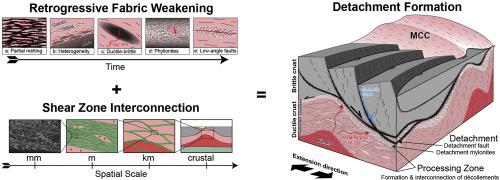当前位置:
X-MOL 学术
›
J. Struct. Geol.
›
论文详情
Our official English website, www.x-mol.net, welcomes your
feedback! (Note: you will need to create a separate account there.)
Shear zone evolution during core complex exhumation – Implications for continental detachments
Journal of Structural Geology ( IF 2.6 ) Pub Date : 2020-11-01 , DOI: 10.1016/j.jsg.2020.104139 J.D. Wiest , H. Fossen , J. Jacobs
Journal of Structural Geology ( IF 2.6 ) Pub Date : 2020-11-01 , DOI: 10.1016/j.jsg.2020.104139 J.D. Wiest , H. Fossen , J. Jacobs

|
Abstract The formation of low-angle detachments involves exhumation of previously ductile material and fault zone weakening. To better understand this relationship, we studied a deeply eroded metamorphic core complex, which formed in the core of the Bergen Arcs (W Norway) during Caledonian post-orogenic collapse. Multi-scale structural mapping in the Oygarden Complex constrains three structural levels characterized by localized shear (Upper Unit), distributed deformation (Middle Unit) and a migmatite double-dome (Lower Unit). All levels show retrogressive E-W stretching accompanied by extension-parallel recumbent folding, albeit, with opposing shear senses at upper and middle/lower levels. The systematic comparison of 23 shear zones constrains the ductile-to-brittle structural evolution. Initially, high temperatures and partial melting controlled pervasive deep crustal flow and ductile doming. During retrogressive shearing, lithological heterogeneity controlled strain localization and channelized fluid flow causing retrograde phyllosilicate growth. This established a feedback loop of fluid-flow, fabric weakening and progressive shear localization. The interconnection of inherited and newly formed weak, phyllosilicate-rich layers promoted the formation of bivergent detachments that rapidly exhumed a dome of previously ductile crust. Retrogressive weakening in a kilometer-wide ductile-to-brittle ‘processing zone’ may be essential for the formation of continental detachments.
中文翻译:

岩心复合体折返过程中的剪切带演化——对大陆拆离的影响
摘要 低角度拆离的形成涉及先前延展性物质的折返和断裂带弱化。为了更好地理解这种关系,我们研究了一个深度侵蚀的变质核复合体,它在加里多尼亚造山后崩塌期间形成于卑尔根弧(挪威西部)的核心。Oygarden Complex 中的多尺度结构映射限制了三个结构层次,其特征是局部剪切(上单元)、分布变形(中单元)和混合岩双穹顶(下单元)。尽管在上层和中/下层具有相反的剪切感,但所有水平都显示出逆向 EW 拉伸,伴随着伸展平行的斜卧折叠。23 个剪切带的系统比较限制了韧性到脆性结构的演变。原来,高温和部分熔化控制了普遍的深部地壳流动和韧性圆顶。在逆行剪切过程中,岩性非均质性控制应变定位和通道化流体流动,导致逆行页硅酸盐生长。这建立了流体流动、织物弱化和渐进剪切定位的反馈回路。继承的和新形成的弱的、富含页硅酸盐的层之间的相互联系促进了双分支脱离的形成,这些脱离迅速挖掘出以前具有延展性的地壳的圆顶。在一公里宽的韧性到脆性“加工区”中的退化减弱对于大陆拆离的形成可能是必不可少的。岩性非均质性控制应变定位和通道化流体流动,导致逆行层状硅酸盐生长。这建立了流体流动、织物弱化和渐进剪切定位的反馈回路。继承的和新形成的弱的、富含页硅酸盐的层之间的相互联系促进了双分支脱离的形成,这些脱离迅速挖掘出以前具有延展性的地壳的圆顶。在一公里宽的韧性到脆性“加工区”中的退化减弱对于大陆拆离的形成可能是必不可少的。岩性非均质性控制应变定位和通道化流体流动,导致逆行层状硅酸盐生长。这建立了流体流动、织物弱化和渐进剪切定位的反馈回路。继承的和新形成的弱的、富含页硅酸盐的层之间的相互联系促进了双分支脱离的形成,这些脱离迅速挖掘出以前具有延展性的地壳的圆顶。在一公里宽的韧性到脆性“加工区”中的退化减弱对于大陆分离的形成可能是必不可少的。富含层状硅酸盐的地层促进了双分支脱离的形成,这些脱离迅速挖掘出先前具有延展性的地壳的圆顶。在一公里宽的韧性到脆性“加工区”中的退化减弱对于大陆拆离的形成可能是必不可少的。富含层状硅酸盐的地层促进了双分支脱离的形成,这些脱离迅速挖掘出先前具有延展性的地壳的圆顶。在一公里宽的韧性到脆性“加工区”中的退化减弱对于大陆拆离的形成可能是必不可少的。
更新日期:2020-11-01
中文翻译:

岩心复合体折返过程中的剪切带演化——对大陆拆离的影响
摘要 低角度拆离的形成涉及先前延展性物质的折返和断裂带弱化。为了更好地理解这种关系,我们研究了一个深度侵蚀的变质核复合体,它在加里多尼亚造山后崩塌期间形成于卑尔根弧(挪威西部)的核心。Oygarden Complex 中的多尺度结构映射限制了三个结构层次,其特征是局部剪切(上单元)、分布变形(中单元)和混合岩双穹顶(下单元)。尽管在上层和中/下层具有相反的剪切感,但所有水平都显示出逆向 EW 拉伸,伴随着伸展平行的斜卧折叠。23 个剪切带的系统比较限制了韧性到脆性结构的演变。原来,高温和部分熔化控制了普遍的深部地壳流动和韧性圆顶。在逆行剪切过程中,岩性非均质性控制应变定位和通道化流体流动,导致逆行页硅酸盐生长。这建立了流体流动、织物弱化和渐进剪切定位的反馈回路。继承的和新形成的弱的、富含页硅酸盐的层之间的相互联系促进了双分支脱离的形成,这些脱离迅速挖掘出以前具有延展性的地壳的圆顶。在一公里宽的韧性到脆性“加工区”中的退化减弱对于大陆拆离的形成可能是必不可少的。岩性非均质性控制应变定位和通道化流体流动,导致逆行层状硅酸盐生长。这建立了流体流动、织物弱化和渐进剪切定位的反馈回路。继承的和新形成的弱的、富含页硅酸盐的层之间的相互联系促进了双分支脱离的形成,这些脱离迅速挖掘出以前具有延展性的地壳的圆顶。在一公里宽的韧性到脆性“加工区”中的退化减弱对于大陆拆离的形成可能是必不可少的。岩性非均质性控制应变定位和通道化流体流动,导致逆行层状硅酸盐生长。这建立了流体流动、织物弱化和渐进剪切定位的反馈回路。继承的和新形成的弱的、富含页硅酸盐的层之间的相互联系促进了双分支脱离的形成,这些脱离迅速挖掘出以前具有延展性的地壳的圆顶。在一公里宽的韧性到脆性“加工区”中的退化减弱对于大陆分离的形成可能是必不可少的。富含层状硅酸盐的地层促进了双分支脱离的形成,这些脱离迅速挖掘出先前具有延展性的地壳的圆顶。在一公里宽的韧性到脆性“加工区”中的退化减弱对于大陆拆离的形成可能是必不可少的。富含层状硅酸盐的地层促进了双分支脱离的形成,这些脱离迅速挖掘出先前具有延展性的地壳的圆顶。在一公里宽的韧性到脆性“加工区”中的退化减弱对于大陆拆离的形成可能是必不可少的。











































 京公网安备 11010802027423号
京公网安备 11010802027423号